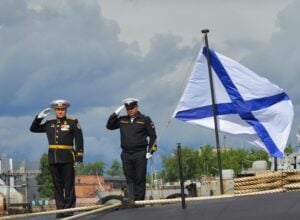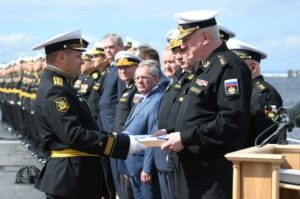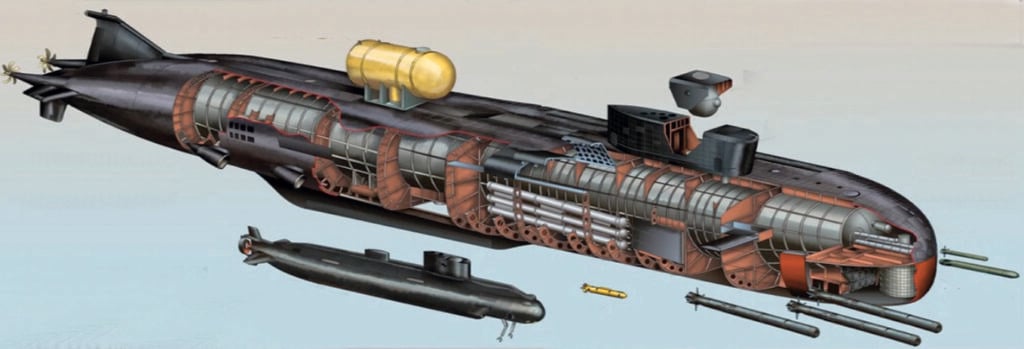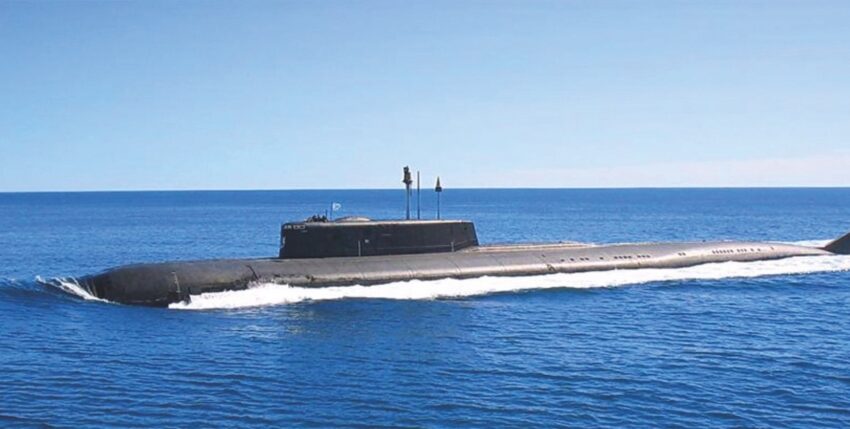
On Friday, 8 July 2022, the "Belgorod" (project 09852) was handed over to the Russian Navy. The ceremonial signing of the acceptance protocol and the handover, during which the St Andrew's flag is hoisted in accordance with Russian procedure, took place at the Sevmash shipyard (Severodvinsk/Arkhangelsk). A press release from the shipyard states that the leadership of the Ministry of Defence, the Navy, the administrations of the Arkhangelsk and Severodvinsk oblasts and representatives of the shipbuilding industry were present.
Launched in 1992 as one of the Oscar II type boats (project 949B), it took twenty years until delivery. In 2000, after the disaster with the predecessor boat K-141 "Kursk", construction was interrupted for more than a decade. The christening of shipyard construction number 664 took place on 23 April 2019. With a length of 184 metres and a displacement of 30,000 tonnes (submerged), K-329 "Belgorod" overshadows other nuclear submarines (SSBN/SSGN) of the Russian Typhoon class and the Ohio class of the US Navy.

Together with its two unfinished sister ships, it actually belongs to the third generation of Russian nuclear submarines. Of the eleven ships built between 1982 and 1996, eight are still in use, two were scrapped and K-141 "Kursk" sank in the Barents Sea in August 2000. As the twelfth ship of this type of submarine (SSGN) designed for the use of cruise missiles, K-329 was revived for a new purpose with a modified design, continued in December 2012 as project 09852 and converted into a "special research and rescue submarine" or multifunctional submarine.
Nuclear-powered mother submarine
Admiral Nikolai Evmenov, Commander-in-Chief of the Navy, emphasised this at the commissioning ceremony: "Today is an important day for us - the signing of the acceptance certificate for the Research submarine "Belgorod" (author's emphasis) and its delivery to the fleet. During the creation of the ship, advanced scientific achievements and the latest construction technologies were used, utilising the existing technical reserves." He continues: "The Belgorod submarine opens up new opportunities for Russia in conducting various studies, enables the organisation of various scientific expeditions and rescue operations in the most remote areas of the world ocean."
The hull of K-329 "Belgorod" has been extended to include a hull section with a dock for small and unmanned submersibles (e.g. UUVs (Unmanned Underwater Vehicles) and submarine rescue vehicles). This means that the former attack submarine will now become a nuclear-powered mother ship for up to eight underwater drones. "Belgorod" is to deploy underwater equipment and carry out cable laying or cable inspections. It can also piggyback smaller (autonomous) underwater vehicles or even take them on board. The Harpsichord 2P-PM autonomous underwater vehicle can be docked in the belly of the ship. There is also a station for carrying submarines up to 70 metres in length (relevant circles mention projects 18511 (Paltus) and 10831 (Losharik), both of which are nuclear-powered deep-sea submersibles with multiple robotic arms that can be deployed at depths of up to 1000 metres and are reminiscent of the Russian KILO class).

More strategic than a research submarine
Furthermore, "Belgorod" will be the carrier for the new Poseidon (2M39) weapons system announced by Vladimir Putin in his State of the Union address on 1 March 2018. Poseidon is also referred to as Status-6 in Russia, while in the USA the system is codenamed Kanyon. It is sometimes classified as a torpedo and sometimes as an underwater drone.
With an "intercontinental" range of almost 10,000 km at a top speed of around 100 km/h (54 knots), Poseidon is capable of delivering its cargo to its target over very long distances. Based on previously leaked technical drawings and the analysis of some test images published by the Russian Ministry of Defence, Poseidon measures approximately 24 m in length and 1.6 m in diameter. The sketches show a warhead about 4 m long and 1.5 m in diameter, with the explosive power ranging from 2 to 100 megatonnes. The "Belgorod" is said to have six such Poseidons. The extent to which reloading is possible (which would require (a) further charge(s)) is not known. Russian media such as TASS and RIA like to refer to secrecy in this context.
In addition to the use of Poseidon, reconnaissance becomes a key component of the tasks of "Belgorod" and her sisters. The sketches circulating show the device for a towed array sonar. Harmony, a sensor network for submarine detection that the Russian military intends to deploy in the Arctic - similar to the US Navy's SOSUS sonar network - is also likely to be used. Furthermore, "Belgorod" can use its UUV or the equipment it carries to place sensors that are powered by underwater nuclear generators. Images also show some kind of towing equipment, presumably to lay underwater cables. There are also areas that suggest the use of jet propellers to manoeuvre the boat in tight spaces or to hold it in position for precision work. The diving depth should be approx. 520 metres (1,700 feet).
Poseidon changes the nature of nuclear deterrence
As with the other reconnaissance ships, command and operational deployment are to be carried out by Glavnoye Upravlenie Glubokovodsk Issledovanii (GUGI), the largely secretive main department for underwater research within the Naval Command Staff at the Ministry of Defence. Due to its strategic importance, it is conceivable that the operational command of "Belgorod" lies directly in the Kremlin, i.e. with the President.
With "Belogorod" and its main armament Poseidon, Moscow hopes to strengthen its second strike capacity. Possible targets for the high-performance torpedo include carrier groups and coastal infrastructure. In March 2018, Vladimir Putin informed the Russian and global public about his plans to strengthen Russia's military response capabilities in response to US deployment plans in Poland and Romania. He showed several videos about new weapon systems - including Poseidon. A spokesperson for the Russian Ministry of Defence confirmed to journalists in March 2019 that the tests with Poseidon had been successfully completed. The training of the carrier vehicle's personnel had been completed (note: the crew size is said to be 25).
There remains a degree of scepticism about both the overall project and the super torpedo. One of the considerable challenges will be evading enemy reconnaissance with such a large weapon system. The requirements for command and control capabilities are also of fundamental importance, especially in the case of such a long-range torpedo with nuclear potential, as it may be necessary to abort the attack or change targets.
Its devastating effect when deployed near the coast is worrying. In addition to the direct effects of hits, secondary effects from tsunamis are conceivable - Fukushima comes to mind here.
Russia is opening a new chapter in naval warfare with its submarine mother ship "Belgorod". Technological advantages no longer speak in favour of submarines to the same extent as before. Added to this are the advances in anti-submarine warfare techniques and methods. The use of big data, the combination of a variety of sensors which, to take just one example, are able to detect the radiation released by submarine reactors, require new approaches. At the same time, it is becoming more expensive to make submarines quieter or better camouflage them. Submarines that can remain in the depths or even close to the seabed and operate there can evade detection. If weapons could even be successfully deployed, for example by Poseidon, traditional maritime warfare under water would undergo a paradigm shift. As would the principle of nuclear deterrence. Ultimately, such a weapon would also open a new chapter in the nuclear weapons control regime.
The "Belgorod" was originally due to be handed over to the fleet in 2020. TASS notes that the Covid-19 pandemic is said to be the cause of the delays. The "Belgorod" began its sea trials in June 2021.
According to Russian sources, the "Belgorod" is to go to the Northern Fleet, as is its sister submarine "Ulyanovsk", project 09853. Construction number 2, "Khabarovsk", project 09851, is to go to the Pacific Fleet. Its arrival is expected in 2024, that of "Ulyanovsk" in 2025.
The Sevmash shipyard in the Nikolskoye estuary near Severodvinsk has built 45 surface ships and 172 submarines since 1939, 132 of them with nuclear propulsion (factory data as of December 2021).
+++++++++++










